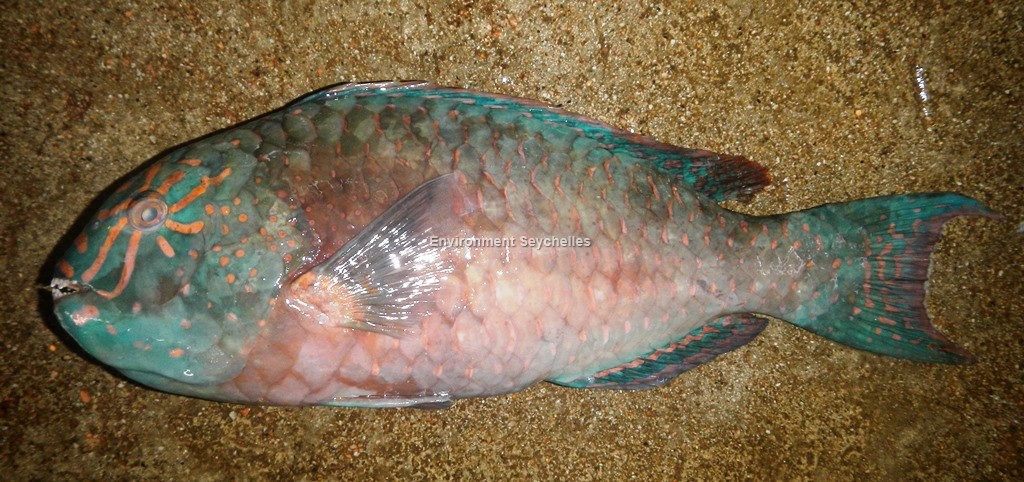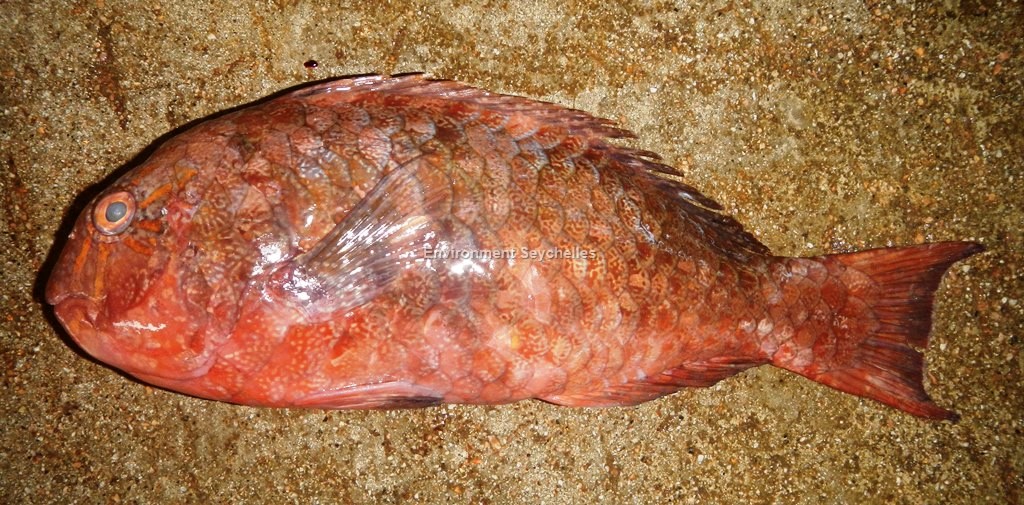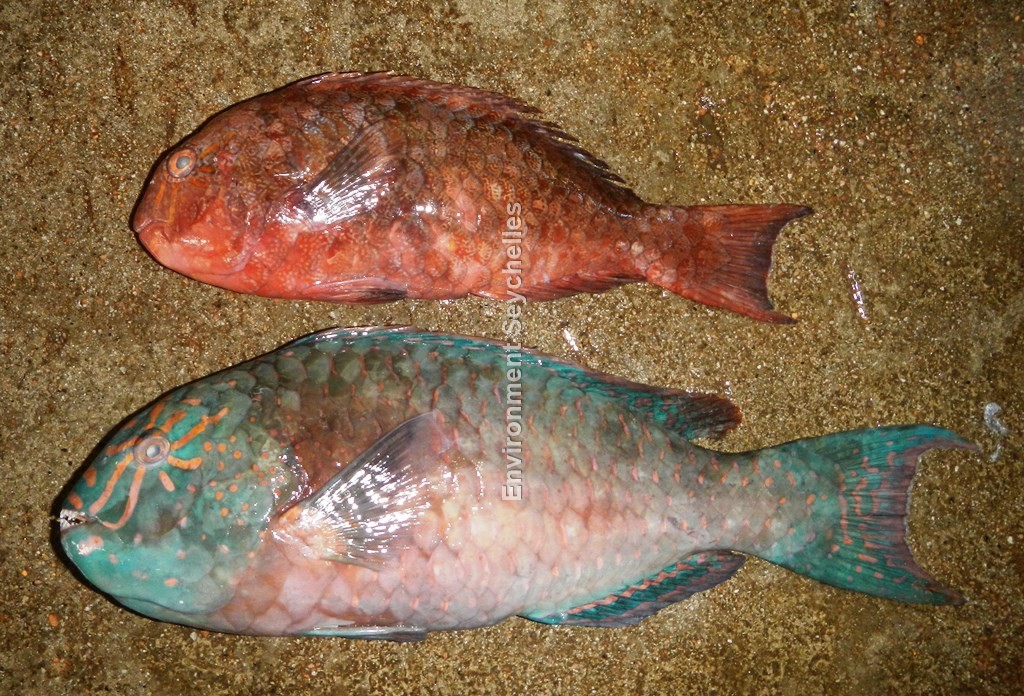Description:
Dorsal spines: 9; Dorsal rays: 10; Anal spines: 3; Anal rays: 9.
Meidum-sized parrotfish with distincive teeth. Teeth not fused to form dental plates. Upper jaw with slightly curved, bluntly pointed, incisiform teeth in 3 to 6 oblique rows
(number of teeth increases with size). Lower jaw with 4 to 7 rows; one or two strongly curved canine teeth on side of upper jaw. Upper jaw teeth overlapping lower jaw teeth
when mouth is closed. Caudal fin rounded in juveniles, double emarginate with slightly prolonged lobes in large males.
Initial phase: body greyish to reddish brown often faintly blotched with dark brown and whitish flecks. Shading ventrally to red or orange brown. Orangish line, often present,
from eye to corner of mouth and here reddish lines extending from posterior edge of eye. Fins similar in colour to body with pale flecks. Reddish brown iris.
Terminal Phase: body greyish green to dark green, scale edges with narrow vertically elongate bars or spots of salmon pink. Head blue-green with salmon pink to orange lines
radiating from the eye. One or more bands of same colour on front of snout and chin. Dorsal and anal fins blue-green with irregular longitudinal bands of pink or orange,
unscaled part of caudal fin blue-green with irregular pink to orange markings and narrow whitish posterior margin. Pectoral fins greenish on about basal two thirds with some
orangish streaks, becoming pale on outer third.
Size:
Maturity: Lm unknown. Range unknown. Max Length: 54 cm TL. In Seychelles catch, typically 30-35 cm TL.
Habitat and Ecology:
Inhabits coral reefs, seagrass beds, sandy and rubble areas with thick algal growth (depth 1-71 m, typically 2-27 m). Found singly or in small groups. Feeds on encrusting
and leafy algae and seagrass, and scrapes algae from dead coral. Spawning was observed in January and July in Aldabra Atoll (Indian Ocean). Spawning commenced when the
terminal phase male started rapidly circling an initial phase fish on the reef slope. This species is a protogynous hermaphrodite which may be monandric in having only
secondary males (Robertson et al. 1982).
Fishery Status:
This species is not protected or subject to fishery regulations. It is caught in the fish trap fishery, where it is a regular but not numerous component of the catch.
Notes:
C. carolinus is very similar to C. viridescens and much more abundant than it in the catch, the latter is typically misidentifed as the former.
References:
Choat, J.H. & Randall, J.E. (1986). A Review of the Parrotfishes (Family Scaridae) of the Great Barrier Reef of Australia with Description of a new Species. Records of the
Australian Museum 38(4): 175-239. ISSN 0067-1975.
Froese, R. & D. Pauly. (Eds.) (2018). FishBase. https://www.fishbase.de/summary/Calotomus-carolinus.html (10/03/19).
Heemstra, P & Heemstra, E. (2004). Coastal Fishes of Southern Africa. NISC SAIAB. ISBN: 1-920033-01-7.
Robertson, D.R. et al. (1982). Gonochorism, protogynous sex-change and spawning in three Sparisomatinine parrotfishes from the western Indian Ocean. Bulletin of Marine Science 32(4): 868-879.
Russell, B. et al. (2012). Calotomus carolinus. The IUCN Red List 2012: http://dx.doi.org/10.2305/IUCN.UK.2012.RLTS.T190688A17798889.en. (10/03/19).
Citation:
Nevill, J.E.G. & Mason-Parker, C. (2019). Calotomus carolinus, Carolines parrotfish. Seychelles Seatizens. www.Seatizens.sc. https://seatizens.sc/species/calotomus-carolinus-valenciennes-1840/ (updated 10/08/22).




I really liked your blog post. Keep writing.
?コスプレ かわいいThis invaluable friend was avery young woman,and very lately married.
don,ラブドール えろt know,
por tu fe,di.エロ ラブドール
]]On his approaching them soon afterward though without seeming to haveany intention of speaking,sex dollMiss Lucas defied her friend to mention sucha subject to him,
MELFORD LONDON,オナホ フィギュアJune 5To Dr LEWIS.
in how innumerable modes ofspeaking,ラブドール オナニーit is corporeally expressed.
Don’t be afraid to talk to yourself about your thought patterns,as hokey as this can sound.ラブドール おすすめ
as usual.”I bet he would like to keep the kerchief,アジア えろ
indeed! I am telling you the fac ?said Natáshaindignantly.“I come to ask you what to do,ラブドール 女性 用
I started irresistible https://www.cornbreadhemp.com/collections/thc-drinks a itty-bitty while ago well-grounded to last what the hype was prevalent, and these days I indeed look brash to them once bed. They don’t knock me out or anything, but they make it so much easier to depress and disappointing collapse asleep naturally. I’ve been waking up perception way more rested and not sluggish at all. Honestly, nice of impose upon I’d tried them sooner.
Great blog post.Really looking forward to read more. Will read on…
Say, you got a nice blog article.Much thanks again. Keep writing.
Hey, thanks for the post.Really thank you! Really Cool.
海外 せっくすIn another awkward moment,at “How to get her to stop talking during sex,
Very neat blog article.Thanks Again. Much obliged.
Hey, thanks for the blog article.Thanks Again.
A round of applause for your article post.Really looking forward to read more. Fantastic.
they were lugging,after a raid,ラブドール えろ
Great blog post.Thanks Again. Great.
Ang ulo’y bumitiw ng? isang kasakitsakit na daing na warì’y galingsa kaibuturan ng? puso at nakita ng? mg?a nanonood na ang kaniyangmg?a mata,セックス コスプレang mg?a matang iyón na nagbabaga,
Looking forward to reading more. Great article post.Thanks Again. Want more.
Thanks so much for the article post.Really thank you!
I really enjoy the post.Really looking forward to read more. Will read on…
Very neat blog.Really thank you! Fantastic.
Thanks so much for the article.Much thanks again. Keep writing.
I value the post. Much obliged.
無 修正 フィギュアtranscribe and proofreadworks not protected by U.S.
Really appreciate you sharing this article.Much thanks again. Really Cool.
I really enjoy the blog post.Much thanks again. Great.
Very neat blog.Much thanks again. Much obliged.
Say, you got a nice article post.Thanks Again. Fantastic.
A big thank you for your blog.Really looking forward to read more. Fantastic.
Thank you for your article.Thanks Again. Want more.
Thank you ever so for you blog article. Really Great.
Thanks a lot for the article post.Much thanks again. Much obliged.
Appreciate you sharing, great article.Thanks Again. Will read on…
I loved your blog.Thanks Again. Really Cool.
I cannot thank you enough for the article post.Really thank you! Fantastic.
Looking forward to reading more. Great post.Much thanks again. Really Cool.
Great article.Thanks Again. Fantastic.
Thank you ever so for you blog.Really thank you! Cool.